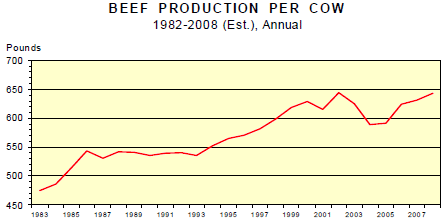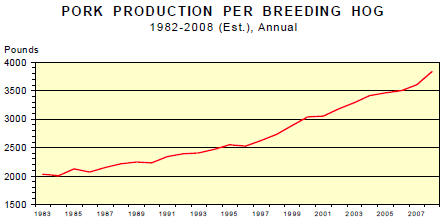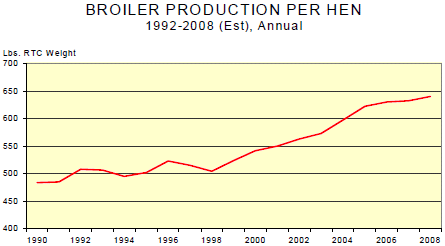



CME: Is Higher Productivity Always a Good Thing?
US - CME's Daily Livestock Report for 24th September 2008.If you missed the CME Group’s webinar on mandatory country-of-origin labeling on Wednesday, it will be available on CME Group website Thursday afternoon. Thank you to the 400-plus who logged in to the webinar and those who attended in person at CME Group headquarters.
High input costs bring production and productivity issues to the forefront so we thought it might be a good time to revisit the productivity records of the three major animal protein sectors. The graphs below provide a very comprehensive measurement of industry productivity: output per female or, in the case of hogs, output per breeding animal since we have no direct estimate of the number of females in the U.S. herd. This measure encompasses most of the key productivity factors including breeding efficiency, birth rate and slaughter weight. Implicit in this measure is also rate of gain. If animals grow faster, they will add more total weight each year and thus increase productivity. The charts generally represent the productivity of fixed assets such as land, buildings and equipment as well since those are closely correlated to breeding animal numbers. Feed efficiency is the most critical productivity factor for which these charts do not provide much information.
It should be noted that these graphs include production from both domestic and imported animals. Growing imports of feeder pigs and market hogs from Canada were one of the drivers of higher productivity even though the trend using just U.S. output is solidly positive. The large drop in beef production per cow from 2003 through 2005 was due to reduced imports of Canadian cattle after the discover of BSE there.
The charts also show the periodic impacts of disease challenges. The dip in chicken production per hen in 1998 was due to some serious problems with J-virus that caused much lower hatchability of broiler eggs. The flattening of pork productivity growth in 2004-2006 demonstrates the impact of porcine circovirus in both Canada and the U.S. The rapid improvement in pork productivity the past two years is, of course, caused by the adoption of circovirus vaccines.



So higher productivity is always good, right? Not if costs are rising and output must be reduced in order to drive prices higher. If demand will not drive prices high enough to cover the higher costs, rising productivity will, to some degree, confound efforts to reduce output and drive prices higher.
That situation is exacerbated by very natural forces that result in yet higher productivity. First, the higher costs provide strong incentives for producers to tighten up their management and increase productivity in order to reduce unit costs. Second, financial losses will drive out the less productive assets/breeding animals. Those reductions may be in the form of whole-firm exits or just cutbacks by firms that remain in business. We aren’t arguing that producers should reduce productivity. They should not and will not. Rising productivity simply means that the cutbacks necessary to restore profitable prices will have to be larger than expected — especially if they are spread over a longer period of time.








